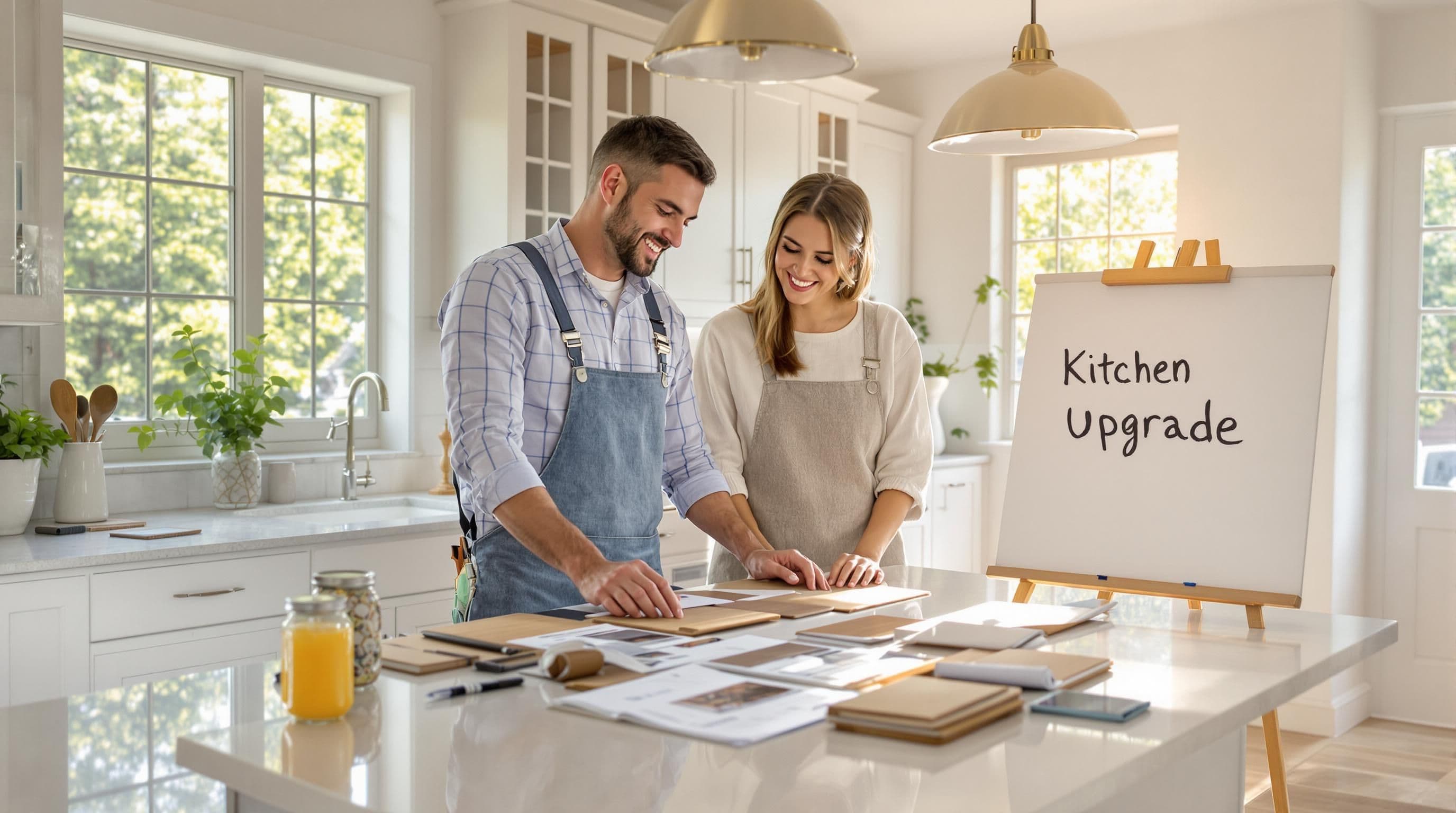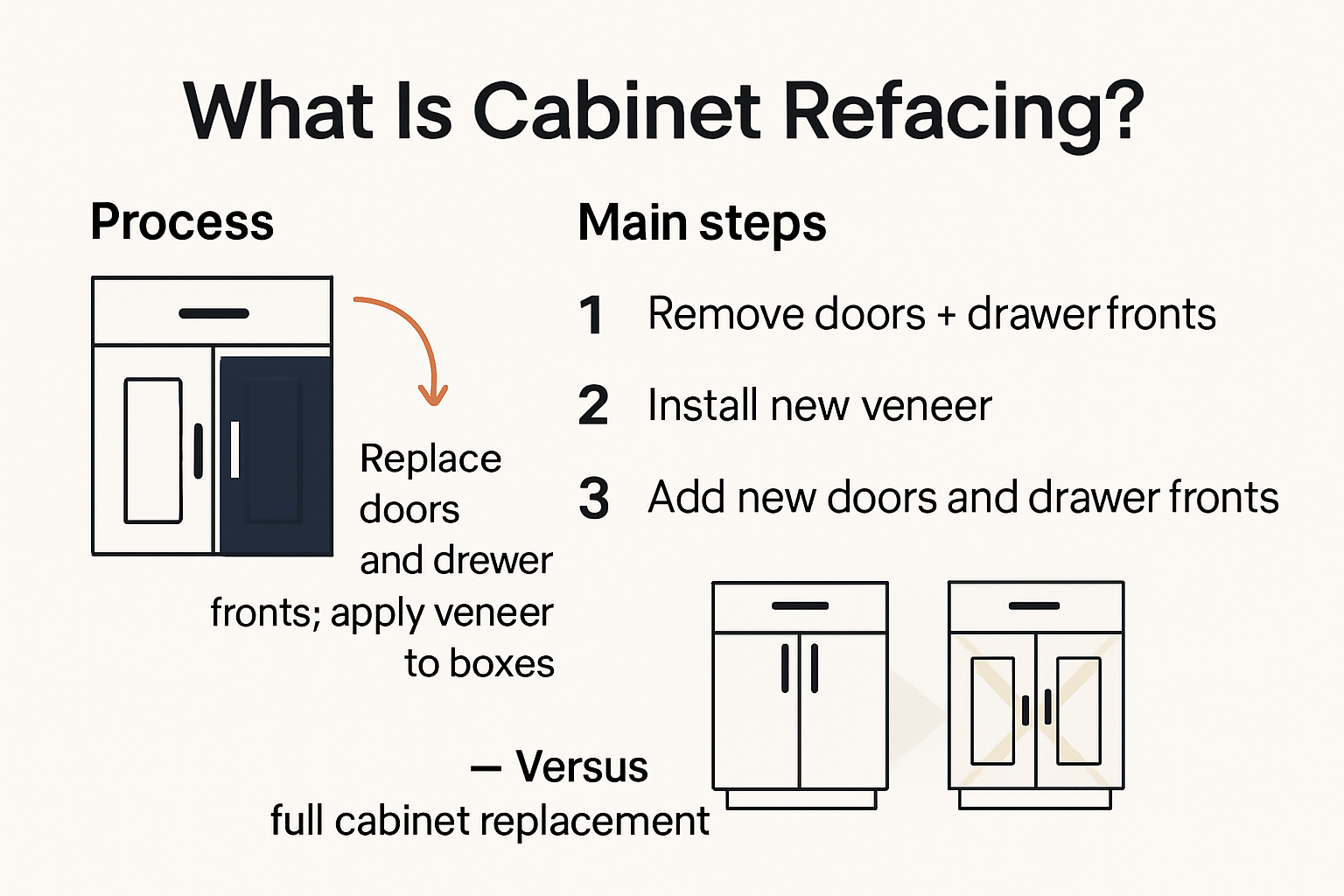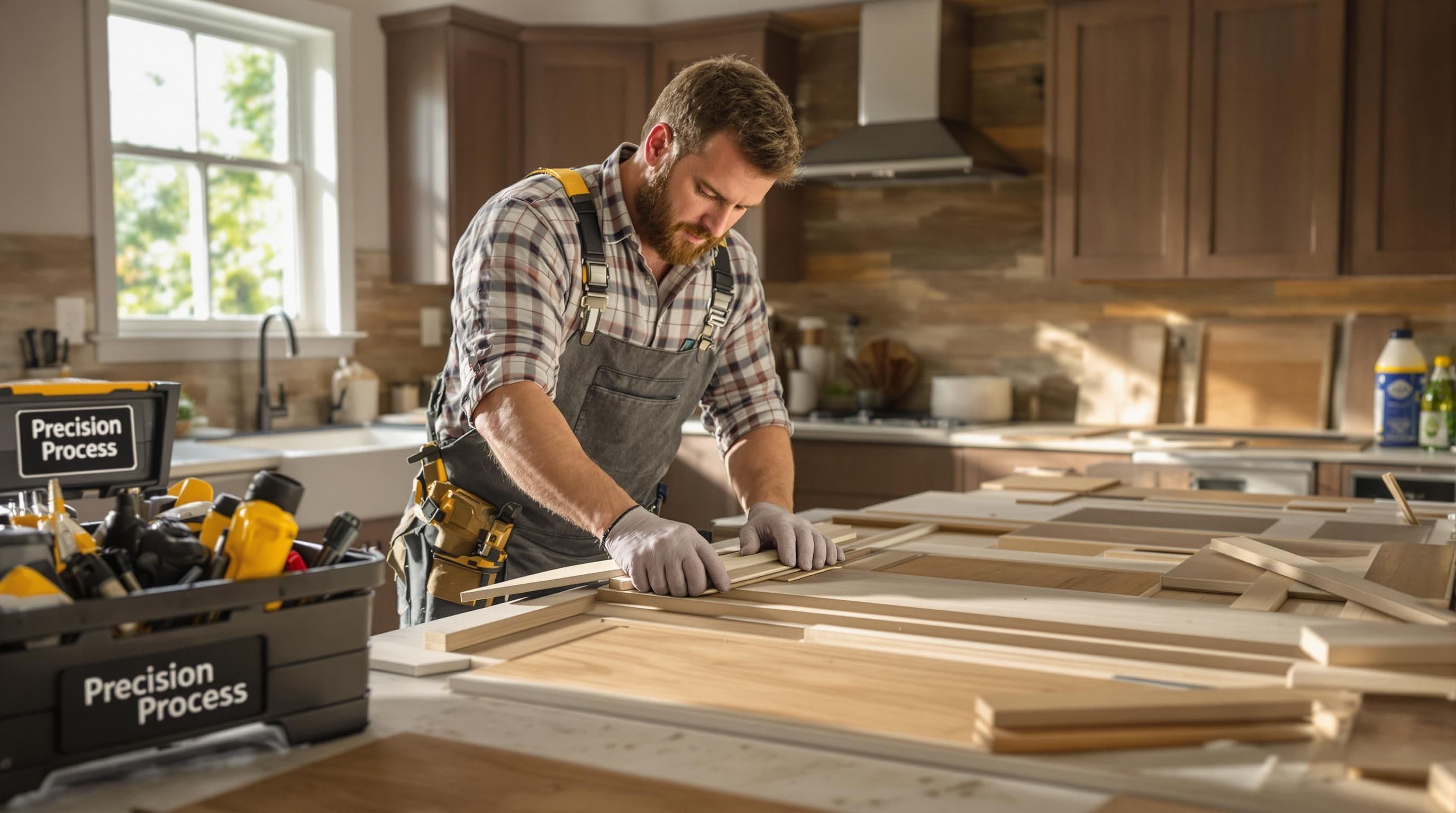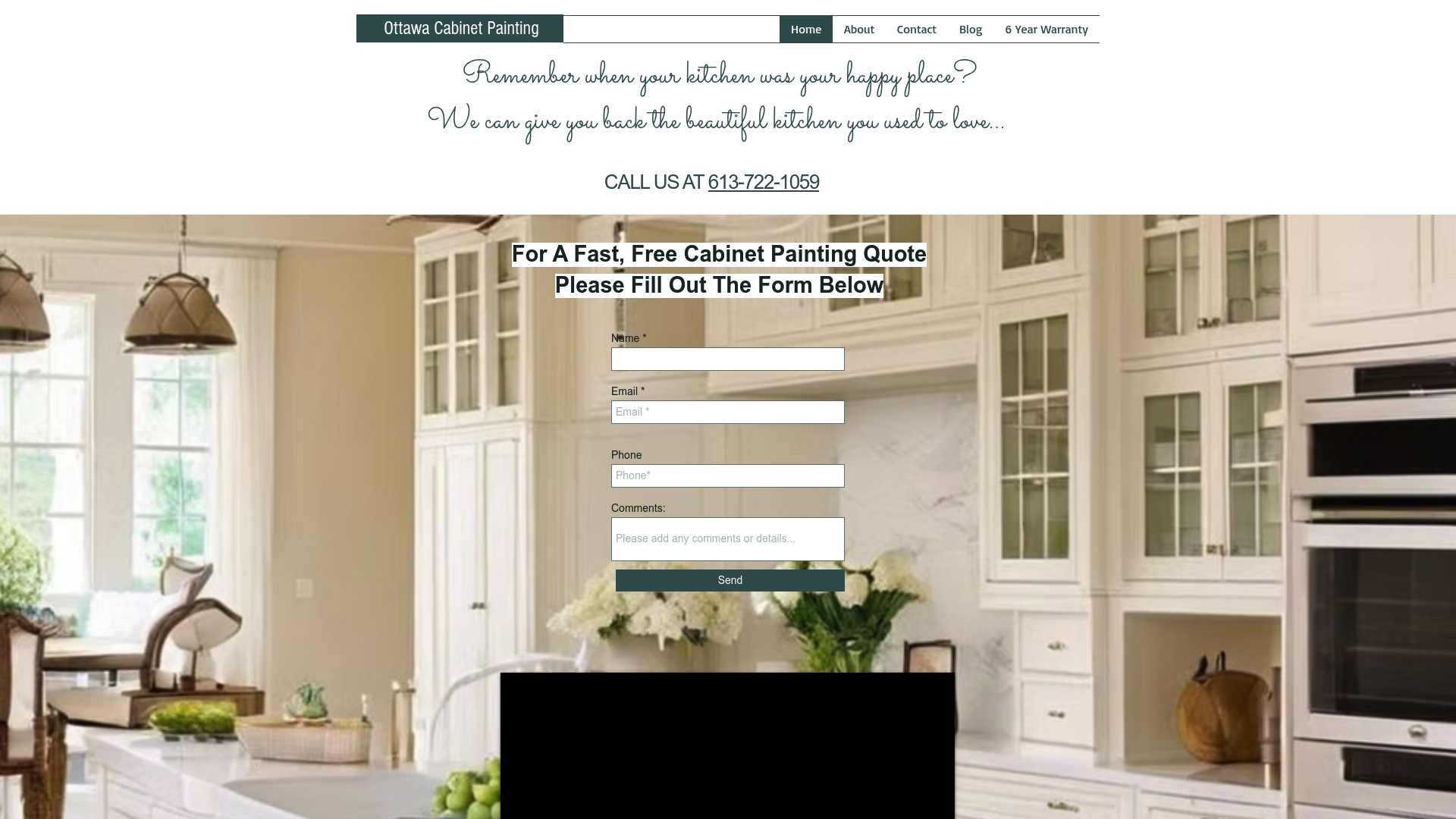What Is Cabinet Refacing? Ottawa Kitchen Upgrades for 2025
- demoore5506
- Jul 23
- 9 min read
Updated: Aug 6

Thinking about giving your kitchen a fresh look without gutting your savings? Most people assume you need a full remodel and weeks of mess to see results. But cabinet refacing can transform your kitchen for 30-50% less than a full replacement and most projects wrap up in under a week. This surprising shortcut could change the way you upgrade your home.
Table of Contents
Quick Summary
Takeaway | Explanation |
Cabinet refacing is cost-effective | Achieve a new kitchen look for 30-50% less than full replacement. |
Minimal disruption during refacing | Most projects complete in 3-5 days, minimizing household interruption. |
Assess cabinet condition before refacing | Ensure your cabinets are structurally sound for effective refacing. |
Design flexibility in finishes | Choose from various colors and materials to match your style. |
High ROI with refacing | Refacing can recoup over 81% of its cost, increasing home value. |
Understanding What Cabinet Refacing Means
Cabinet refacing is a strategic home improvement technique that transforms kitchen aesthetics without the extensive cost and disruption of a complete cabinet replacement. This method offers homeowners an efficient way to modernize their kitchen’s appearance while preserving the existing cabinet framework.

The Fundamental Process of Refacing
At its core, cabinet refacing involves a meticulous process of updating the visible surfaces of kitchen cabinets. According to This Old House, the technique fundamentally requires removing existing cabinet doors and drawer fronts, then applying a new veneer or laminate over the original cabinet boxes. This approach allows for a dramatic visual transformation without dismantling the entire kitchen infrastructure.
The process typically includes several key steps. First, professionals carefully remove all existing doors and drawer fronts. Next, they apply a thin layer of wood veneer, laminate, or rigid thermofoil to the cabinet frames, creating a fresh, uniform surface. Finally, new doors and drawer fronts are installed to match the new finish, complementing the updated cabinet boxes.
To help you better understand the precise order and purpose of each step, here is a table outlining the typical cabinet refacing process:
Step | Description |
1. Assessment | Inspect cabinets to ensure structure is sound for refacing |
2. Remove Doors/Drawers | Take off all cabinet doors, drawer fronts, and hardware |
3. Surface Prep | Clean and sand cabinet surfaces for veneer adhesion |
4. Apply Veneer/Laminate | Cover exposed cabinet boxes with new veneer, laminate, or thermofoil |
5. Install New Doors/Drawers | Attach new doors and drawer fronts matching selected finish |
6. Add Hardware | Install handles, pulls, and knobs for final touches |
7. Final Inspection | Ensure proper fit, alignment, and clean-up |
Cost-Effective Kitchen Transformation
One of the most compelling aspects of cabinet refacing is its remarkable cost efficiency. The Spruce reveals that homeowners can achieve a completely new kitchen look for approximately 30-50% less than the expense of full cabinet replacement. This significant cost savings makes refacing an attractive option for budget-conscious individuals seeking a substantial kitchen upgrade.
Beyond financial benefits, cabinet refacing offers minimal disruption to your home environment. Unlike full renovations that can take weeks or months, most refacing projects can be completed within several days. Homeowners can maintain their kitchen’s functional layout while dramatically improving its aesthetic appeal. The process requires less labor, fewer materials, and creates substantially less waste compared to complete cabinet replacement.
Refacing also provides incredible design flexibility. Homeowners can select from numerous finishes, colors, and styles to match their evolving design preferences. Whether you desire a contemporary sleek look or a classic traditional appearance, refacing allows for personalized customization without structural modifications.
The technique is particularly advantageous for kitchens with structurally sound cabinet boxes. If your existing cabinets are in good condition but look outdated, refacing presents an ideal solution. By preserving the original cabinet framework and focusing on surface updates, you can breathe new life into your kitchen without the extensive investment of a full renovation.
Ultimately, cabinet refacing represents a smart, strategic approach to kitchen improvements. It balances aesthetic transformation, cost-effectiveness, and minimal disruption, making it an increasingly popular choice for homeowners seeking meaningful kitchen upgrades in 2025 and beyond.
How Cabinet Refacing Works in Your Home
Cabinet refacing transforms your kitchen’s appearance through a precise, systematic approach that preserves your existing kitchen layout while delivering a dramatic aesthetic upgrade. This method involves strategic modifications that breathe new life into your space without the extensive disruption of a complete renovation.
Professional Assessment and Preparation
The refacing process begins with a comprehensive professional evaluation of your current kitchen cabinets. According to Better Homes & Gardens, experts first assess the structural integrity of your cabinet boxes to determine their suitability for refacing. Not all cabinets are ideal candidates. Professionals look for solid construction, minimal damage, and a stable framework that can support the new veneer and door installations.
Preparing the kitchen involves meticulous steps. Technicians carefully remove existing cabinet doors, drawer fronts, and hardware. They clean and sand the cabinet surfaces to ensure optimal adhesion of the new veneer. This preparation is crucial for achieving a smooth, professional finish that looks seamless and high-end.
Precise Transformation Techniques

This Old House outlines the core techniques of cabinet refacing. Professionals apply a thin layer of wood veneer, laminate, or rigid thermofoil to the exposed cabinet frames. These materials come in various colors, textures, and finishes, allowing homeowners to customize their kitchen’s appearance completely.
The application process requires precision. Technicians carefully measure and cut the veneer to fit exactly, ensuring no gaps or uneven edges. They use specialized adhesives and tools to create a smooth, uniform surface that looks like a brand new installation. New doors and drawer fronts are then crafted to match the chosen finish, creating a cohesive and refreshed look.
Hardware and Finishing Touches
A critical component of cabinet refacing involves updating hardware. Homeowners can select from an array of handles, knobs, and pulls that complement their new cabinet finish. This step allows for additional personalization, enabling you to shift from traditional to modern styles or match your kitchen’s evolving design aesthetic.
The final stage involves carefully installing the new doors, drawer fronts, and hardware. Precision is key to ensuring perfect alignment, smooth operation, and a professional appearance. Experienced technicians use specialized techniques to guarantee that each element fits perfectly, creating a seamless transformation that looks like a complete kitchen renovation.
Refacing typically takes 3-5 days, a significantly shorter timeline compared to full kitchen remodels. This quick turnaround means minimal disruption to your daily life. You can continue using your kitchen with only brief periods of limited access during the installation process.
Ultimately, cabinet refacing represents a smart, efficient approach to kitchen updates. By focusing on surface transformations and preserving existing structures, homeowners can achieve a stunning kitchen makeover that feels entirely new while maintaining the practical layout and functionality of their existing space.
Cabinet Refacing vs. Replacing or Refinishing
Homeowners seeking kitchen updates face multiple options for transforming their cabinets, each with distinct advantages and considerations. Understanding the differences between cabinet refacing, replacement, and refinishing helps you make an informed decision that aligns with your budget, timeline, and aesthetic goals.
To clarify how refacing compares to full replacement and refinishing, here is a comparison table summarizing their major differences in cost, duration, disruption, and impact:
Feature | Refacing | Replacing | Refinishing |
Average Cost (Standard Kitchen) | $8,000–$15,000 | $20,000–$40,000 | Lower than refacing |
Timeline | 3–5 days | 2–6 weeks | 2–4 days |
Visual Transformation | Dramatic | Most dramatic | Least dramatic |
Disruption | Minimal | Significant | Moderate |
Best For | Structurally sound cabinets, design refresh | Damaged/old cabinets, layout change | Subtle color update, low wear |
Environmental Impact | Less waste, reuses boxes | More waste, new materials | Least new material |
Cost and Investment Considerations
Shaker Cabinets provides a clear financial perspective on these options. Cabinet refacing typically costs between $8,000 and $15,000 for a standard kitchen, representing a significant cost savings compared to full replacement, which can range from $20,000 to $40,000. This substantial price difference makes refacing an attractive option for budget-conscious homeowners looking to refresh their kitchen’s appearance without a major financial investment.
Refinishing, another alternative, involves sanding and repainting existing cabinets, which can be even less expensive but offers limited aesthetic improvements. While refinishing might seem most economical, it provides the least dramatic transformation and may not address underlying structural issues or outdated designs.
Structural Limitations and Design Flexibility
According to Deslaurier Custom Cabinets, the choice between refacing and replacing depends critically on the existing cabinet’s condition. Refacing works best when cabinet boxes are structurally sound and in good condition. It allows for surface-level updates without complete demolition, preserving the kitchen’s existing layout and functionality.
Cabinet replacement offers the most comprehensive transformation. This option becomes ideal when:
Existing cabinets are significantly damaged
You want to completely redesign the kitchen layout
Structural integrity of current cabinets is compromised
You desire entirely new storage configurations
Refinishing provides the most limited approach, essentially working with the existing surface by painting or staining. This method works best for cabinets with minimal wear and those seeking a subtle color update.
Time and Disruption Factors
Guilin Cabinets highlights the significant time differences between these approaches. Refacing typically takes 3-5 days, with minimal kitchen disruption. In contrast, full cabinet replacement can consume 2-6 weeks, creating substantial household interruption.
Refinishing falls between these extremes, usually taking 2-4 days but offering the least dramatic visual change. For homeowners seeking a quick, cost-effective update with minimal disruption, refacing emerges as the most balanced solution.
Environmental considerations also play a role. Shaker Cabinets notes that refacing is more environmentally friendly, reducing waste by preserving existing cabinet structures and minimizing material consumption.
Ultimately, the best choice depends on your specific circumstances. Refacing offers an ideal middle ground for homeowners wanting significant aesthetic improvement without the cost and complexity of full replacement. It balances affordability, speed, and visual transformation, making it an increasingly popular choice for kitchen updates in 2025 and beyond.
Is Cabinet Refacing Right for Your Needs?
Determining whether cabinet refacing is the ideal solution for your kitchen requires careful evaluation of multiple factors. This comprehensive assessment helps homeowners make an informed decision that balances aesthetic desires, budget constraints, and practical considerations.
Assessing Your Current Kitchen Infrastructure
This Old House suggests that cabinet refacing works best when existing cabinet boxes are structurally sound and in good condition. Key indicators that refacing might be right for you include:
Cabinets with minimal damage or wear
Sturdy frame construction
Functional drawer slides and hinges
No significant water damage or structural issues
Desire to maintain current kitchen layout
Financial and Value Considerations
Remodeling Magazine reveals a compelling financial argument for cabinet refacing. A midrange minor kitchen remodel involving refacing can recoup more than 81% of its cost, significantly outperforming major kitchen renovations that typically recover only 59% of the investment.
Beyond immediate financial benefits, refacing offers substantial cost savings. Compared to full cabinet replacement, refacing can reduce expenses by 30-50%. This makes it an attractive option for homeowners seeking a significant kitchen transformation without the hefty price tag of a complete renovation.
Lifestyle and Practical Implications
The COVID-19 pandemic has reshaped home improvement strategies, with Freedonia Group noting increased interest in cost-effective renovation options. Cabinet refacing emerges as an ideal solution for several lifestyle scenarios:
Homeowners wanting a quick kitchen refresh
Individuals with limited renovation budgets
Those seeking minimal household disruption
Environmentally conscious consumers looking to reduce waste
Families needing a rapid kitchen update without extensive construction
Refacing is particularly suitable if you appreciate your current kitchen layout but feel the aesthetic has become outdated. It allows for dramatic visual transformation while maintaining the functional elements of your existing kitchen.
Consider your long-term plans as well. If you anticipate selling your home in the next 3-5 years, refacing can provide an excellent return on investment by modernizing your kitchen’s appearance without significant financial risk.
Ultimately, cabinet refacing represents a strategic middle ground between doing nothing and complete replacement. It offers a balanced approach that combines aesthetic renewal, cost-effectiveness, and minimal disruption. By carefully evaluating your specific needs, budget, and kitchen condition, you can determine whether this innovative renovation method is the right choice for your home in 2025 and beyond.
Frequently Asked Questions
What is cabinet refacing?
Cabinet refacing is a cost-effective home improvement method that updates the visible surfaces of kitchen cabinets without a full replacement. It involves applying a new veneer or laminate over the existing cabinet framework, dramatically transforming the kitchen’s appearance.
How much does cabinet refacing cost compared to replacing cabinets?
Cabinet refacing typically costs 30-50% less than full cabinet replacement. For a standard kitchen, refacing ranges from $8,000 to $15,000, while replacement can range from $20,000 to $40,000.
How long does the cabinet refacing process take?
Most cabinet refacing projects can be completed within 3 to 5 days, minimizing disruption in your home compared to full renovations, which can take weeks to months.
Is cabinet refacing suitable for all kitchens?
Cabinet refacing is most suitable for kitchens with structurally sound cabinets that are in good condition. If your cabinets show significant damage or wear, full replacement may be necessary.
Ready to Transform Your Kitchen Without the Stress?
If you are drawn to the idea of a fresh, high-end look without the mess or cost of total cabinet replacement, you are not alone. Many homeowners feel stuck with outdated finishes but worry about the chaos, noise, and budget headaches that come with major renovations. As highlighted in our article, cabinet refacing and refinishing deliver stunning results by upgrading only what you see, preserving your kitchen’s functional layout and structure while saving considerable time and money.

At Ottawa Cabinet Painting, we specialize in transforming existing cabinets with a meticulous process that brings out a silky, durable finish designed to last. You get a kitchen that feels brand new—without demolition or disruption. Discover how our dedicated approach can help you avoid renovation chaos while achieving the look you deserve. Start your transformation today by exploring our cabinet refinishing solutions and request your free, no-obligation quote before availability fills up.
Comments